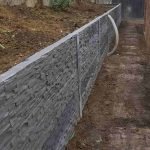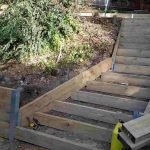Introduction
Building a maintaining wall can be a significant investment for your property, both in regards to looks and functionality. Whether you're aiming to prevent soil disintegration, develop level balconies, or enhance your landscape's appearance, working with the best retaining wall contractor is vital. This post will act as your comprehensive guide on what to expect when dealing with these professionals, from preliminary assessments to predict conclusion. We'll cover everything you need to understand about selecting a retaining wall builder, the materials involved (like concrete sleepers, H beams, wood sleepers, timber sleepers, and stone), and common risks to avoid.
Step-by-Step Guide: What to Expect When Working with a Retaining Wall Contractor
When engaging a retaining wall installer, it's vital to comprehend the entire process. From idea to execution, every action matters. Here's an in-depth overview of what you should anticipate:
1. Preliminary Assessment and Website Assessment
What takes place throughout the first meeting?
During your initial assessment, the professional will visit your website to examine conditions like topography, soil type, and drain problems. This assessment is vital due to the fact that it helps determine the best style and products for your maintaining wall.
- Key concerns to ask: What experience do you have with comparable projects? Can you supply referrals or examples of previous work?
The specialist will examine whether a stone, wood sleeper, or other materials are suitable based upon site conditions.
2. Style Phase
How does the design procedure work?

Once evaluations are completed, the style phase begins. The specialist might provide several style options customized to your needs:
- Traditional gravity walls Cantilevered walls Sheet stack walls
Each alternative has its benefits and drawbacks, so comprehending how they function is critical.
3. Material Selection
What products must I consider?
The choice of materials can considerably impact toughness and looks:
- Concrete Sleepers: Resilient and versatile; perfect for modern-day designs. Timber Sleepers: Visual appeal but may require more maintenance. Stone: Very resilient but often more expensive.
Your professional ought to assist you weigh the advantages of each material versus your budget.
4. Cost Estimates and Budgeting
What must I expect concerning costs?
A professional contractor will offer a comprehensive quote that includes labor, products, permits, and any additional site preparation needed.
Typical Cost Breakdown:
|Product|Estimated Cost|| -----------------------|----------------|| Products|$X per system|| Labor|$Y per hour|| Allows|$Z|
Understanding this breakdown helps in budgeting effectively.
5. Permitting Process
Do I need permits for my maintaining wall?

In most cases, yes! Your professional will usually manage this process however guarantee they discuss it with you upfront:
- Local policies differ widely. Some areas may have limitations on height or material use.
It's important to abide by regional laws to avoid future complications.
6. Preparing the Site for Construction
What preparations are necessary before building?
Site preparation involves clearing plants, grading land if essential, and making sure proper drain systems are in place.
This step is important because improper drainage can cause structural failure over time.
7. Installation Begins
What can I anticipate during installation?
Once whatever is established, building and construction starts! Throughout this stage:
- The specialist will set out the foundation. Proper leveling is important for effectiveness.
Expect some sound and disruption; however, excellent contractors reduce trouble wherever possible.
8. Quality Control Checks Throughout Installation
How do I know if quality standards are met?
Throughout the installation, routine quality checks must be performed by both you and the specialist:
- Confirm that products match specifications. Ensure appropriate positioning and leveling at all stages.
Keep an open line of interaction; don't hesitate to voice concerns!
9. Final Touches and Backfilling
What occurs after construction?
After installation comes backfilling-- this includes filling out behind the wall with soil while ensuring proper drain options remain reliable (like weep holes).
Final touches consist of landscaping around the wall or including features like lighting or steps depending upon your plans.
10. Upkeep Standards Post-Installation
How do I maintain my brand-new maintaining wall?
Your maintaining wall will require periodic inspections for indications of wear or damage such as fractures or erosion:
- Clean out debris from weep holes regularly. Monitor plant development near wood walls which could cause rot if not handled properly.
A properly maintained wall can last decades!
FAQs
1. The length of time does it take to build a keeping wall?
The period mostly depends on size and intricacy however usually ranges from a few days up to 2 weeks.
2. What's better-- wood or stone for maintaining walls?
It depends on aesthetic choice versus toughness needs; https://writeablog.net/nelsearmzf/how-to-team-up-efficiently-with-your-retaining-wall-builder wood offers warmth while stone provides longevity.

3. Can I develop a retaining wall myself?
While DIY is an option for smaller sized tasks, working with an experienced contractor guarantees compliance with regional codes and reduces possible errors.
4. Do keeping walls require drainage?
Yes! Appropriate drainage prevents water buildup that might compromise structural stability over time.
5. What kinds of walls are available?
Common types include gravity walls, cantilevered walls, anchored walls, etc, each matched for various applications based on stability needs.
6. Exist environmental considerations when building?
Always speak with professionals relating to environmental effect evaluations particularly concerning regional wildlife habitats or water circulation patterns.
Conclusion
Navigating through the process of working with a retaining wall contractor can at first seem challenging-- yet equipped with this guide detailing what to anticipate every action of the way makes it manageable! From mindful planning during consultations all the method through maintenance post-installation-- each phase needs attention-to-detail that only skilled specialists come up with effectively!
Remember that effective collaboration hinges upon clear interaction in between you as the homeowner & & professionals throughout-- the better notified you are about each aspect mentioned here implies smoother sailing ahead towards attaining spectacular lead to boosting both functionality & & appeal within your landscapes!